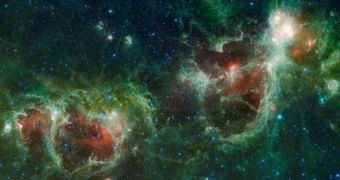In spite of having been launched only a few months ago, the WISE Space Telescope is already proving its worth in the eye of astronomers. Its goal is to survey the entire Universe one and a half times over, but in the meantime, it's providing some spectacular vistas of nebulae, stars, near-Earth objects (NEO), asteroids, and dark objects that are too cold to be picked up by less sensitive telescopes. Its most recent feat is snapping an image of the Heart and Soul nebulae, in an unprecedented level of detail. At this point, WISE is about 75 percent complete in its first sweep of the Universe, Space reports.
The Wide-field Infrared Survey Explorer was designed specifically to be able to capture incredible details in infrared wavelengths. Its detectors are very sensitive to this portion of the electromagnetic spectrum, and the fact that the entire observatory is kept at very low temperatures also helps considerably. After completing the calibration and commissioning phases of the mission, engineers have fine-tuned the observatory so that it captures about 7,500 images of the Universe each day, which can then be pieced together in a mosaic. Such was the case with the new image too, experts say.
“This new image demonstrates the power of WISE to capture vast regions. We're looking north, south, east and west to map the whole sky,” stated today the principal investigator of the WISE mission, Ned Wright. The expert, who is based at the University of California in Los Angeles (UCLA), spoke in front of colleagues in Miami, at the 216th meeting of the American Astronomical Society (AAS 2010). The two targets are located in the constellation Cassiopeia, some 6,000 light-years away. This is fairly close in astronomical terms. The nebulae got their names because they both resemble human hearts.
Wright added that the new mosaic is composed of no less than 1,147 individual images, which have been pieced together digitally by experts. The combined exposure time for the photo was 3 ½ hours, he further explained. WISE is on a polar orbit around the planet, meaning that it circles it over both poles. This allows it to snap incredibly-detailed images, from a unique vantage point. The same orbit is used by weather and spy satellites, as it also provides the best view of Earth.

 14 DAY TRIAL //
14 DAY TRIAL //